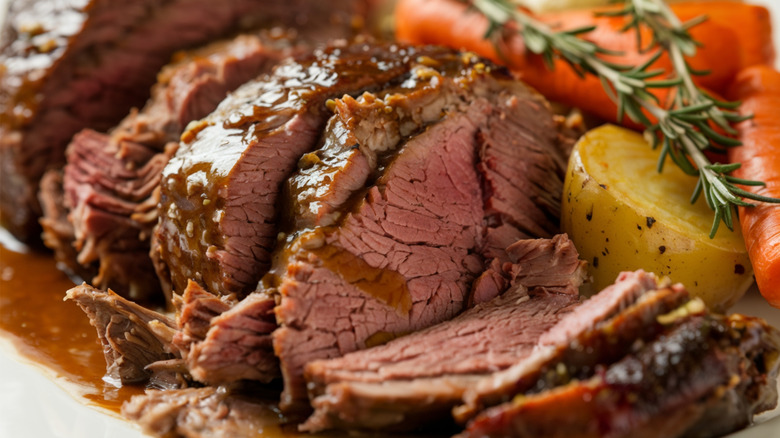Fix A Tough, Chewy Roast After Cooking With One Ingredient
Preparing a roast is a delicate process. Sometimes, even after hours of prepping and cooking, the meat turns out tough and chewy — don't worry, it happens to the best of us. While it's disappointing, Gail Simmons, from the City Harvest Share Lunch Fight Hunger event, shared a simple solution using just one ingredient: broth.
A mistake everyone makes with pot roast is letting it get too dry, which can lead to a rather unpleasant bite. "If your meat is still tough afterwards or you overcooked it, try adding more liquid (broth), cover and steam at low heat to tenderize the meat," Simmons told Food Republic. This process will help suffuse the meat with moisture, and ideally add flavor that was lost during the initial cooking process. While it's not a perfect fix, the moisture-rich environment should limit your pot roast, roast beef, or any other red meat from overcooking even more.
"If that doesn't work, repurpose the meat but either shredding it, or using it for a dish like beef stroganoff," Simmons continued. "For beef stroganoff, try chopping it up and submerging it in a flavorful liquid to rehydrate it." While your roast may not be great by itself, all is not lost. Rehydrating it in a new sauce or its leftover juices (for recipes that aren't so dependent on texture) works great. This trick is also ideal if you are reheating your roast so it doesn't lose tenderness. However, Simmons was quick to point out that it's easier to prevent a roast from drying out, rather than fixing it after the damage is done.
How to prevent roasts from becoming tough and chewy
How your roast turns out often depends on how your preparation process, long before a grain of salt or a lick of heat comes anywhere near it. "Before getting started, make sure to get your cut of meat from a trusted butcher," said Gail Simmons. "Bring the meat from the fridge to room temperature for at least 45 minutes to an hour before cooking, and don't season the meat too far in advance[,] because that leaches moisture."
A roast needs to cook low and slow to develop the ideal flavor and texture, so you never want to do anything that could inhibit its ability to maintain a juicy tenderness. Simmons pointed out that this is especially true for the cuts used in roast beef, which need ample amounts of low heat to break down their connective tissues. You can also include acidic ingredients to help those tissues break down and make tender and tangy roast beef with some intense flavor.
David Rose's prime rib tip is also great for avoiding overcooked beef. He recommended, "carryover cooking," where you remove the roast just before it's done to let it rest while still cooking internally. Remember, the internal temperature of beef continues to rise for 20 minutes after removing it from the oven. By letting it rest, covered, you keep that momentum going while allowing it to gradually cool to a consumable temperature.


